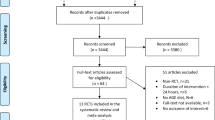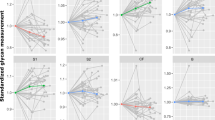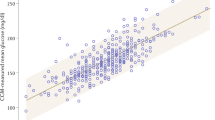Abstract
Advanced glycation end products (AGEs) are glycated proteins or lipids derived from complex metabolic pathways involved in the pathophysiology of various diseases, especially diabetes and diabetes-related complications. These compounds are omnipresent in human life, with both endogenous and exogenous sources. Despite the well-elucidated disease mechanisms, little is known about the AGEs/nutrition nexus in the circles of clinical practice recommendations. This review seeks to translate the accumulated knowledge about the biochemistry and pathophysiology of AGEs into a nutritional intervention based on real-world prescriptions.
This is a preview of subscription content, access via your institution
Access options
Subscribe to this journal
Receive 12 print issues and online access
$259.00 per year
only $21.58 per issue
Buy this article
- Purchase on Springer Link
- Instant access to full article PDF
Prices may be subject to local taxes which are calculated during checkout


Similar content being viewed by others
References
Castro JP, El-Atat FA, McFarlane SI, Aneja A, Sowers JR. Cardiometabolic syndrome: pathophysiology and treatment. Curr Hypertens Rep. 2003;5:393–401. https://doi.org/10.1007/s11906-003-0085-y
Kirk EP, Klein S. Pathogenesis and pathophysiology of the cardiometabolic syndrome. J Clin Hypertens. 2009;11:761–5. https://doi.org/10.1111/j.1559-4572.2009.00054.x
Forbes JM, Cooper ME. Mechanisms of diabetic complications. Physiological Rev. 2013;93:137–88. https://doi.org/10.1152/physrev.00045.2011
Jha JC, Banal C, Chow BS, Cooper ME, Jandeleit-Dahm K. Diabetes and kidney disease: role of oxidative stress. Antioxid Redox Signal. 2016;25:657–84. https://doi.org/10.1089/ars.2016.6664
Goldin A, Beckman JA, Schmidt AM, Creager MA. Advanced glycation end products: sparking the development of diabetic vascular injury. Circulation. 2006;114:597–605. https://doi.org/10.1161/CIRCULATIONAHA.106.621854
Vlassara H, Striker GE. AGE restriction in diabetes mellitus: a paradigm shift. Nat Rev Endocrinol. 2011;7:526–39. https://doi.org/10.1038/nrendo.2011.74
Ostry A, Young ML, Hughes M. The quality of nutritional information available on popular websites: a content analysis. Health Educ Res. 2008;23:648–55. https://doi.org/10.1093/her/cym050
Storey KE, Forbes LE, Fraser SN, Spence JC, Plotnikoff RC, Raine KD, et al. Diet quality, nutrition and physical activity among adolescents: the Web-SPAN (Web-Survey of Physical Activity and Nutrition) project. Public Health Nutr. 2009;12:2009–17. https://doi.org/10.1017/S1368980009990292
Aragno M, Mastrocola R. Dietary sugars and endogenous formation of advanced glycation endproducts: emerging mechanisms of disease. Nutrients. 2017;9. https://doi.org/10.3390/nu9040385
Perrone A, Giovino A, Benny J, Martinelli F. Advanced glycation end products (AGEs): biochemistry, signaling, analytical methods, and epigenetic effects. Oxid Med Cell Longev. 2020;2020:3818196 https://doi.org/10.1155/2020/3818196
Gautieri A, Passini FS, Silvan U, Guizar-Sicairos M, Carimati G, Volpi P, et al. Advanced glycation end-products: mechanics of aged collagen from molecule to tissue. Matrix Biol. 2017;59:95–108. https://doi.org/10.1016/j.matbio.2016.09.001
Gkogkolou P, Bohm M. Advanced glycation end products: key players in skin aging? Derm-Endocrinol. 2012;4:259–70. https://doi.org/10.4161/derm.22028
Yamagishi S, Nakamura K, Imaizumi T. Advanced glycation end products (AGEs) and diabetic vascular complications. Curr Diabetes Rev. 2005;1:93–106. https://doi.org/10.2174/1573399052952631
Hamada Y, Araki N, Koh N, Nakamura J, Horiuchi S, Hotta N. Rapid formation of advanced glycation end products by intermediate metabolites of glycolytic pathway and polyol pathway. Biochem Biophys Res Commun. 1996;228:539–43. https://doi.org/10.1006/bbrc.1996.1695
Bonora M, Patergnani S, Rimessi A, De Marchi E, Suski JM, Bononi A, et al. ATP synthesis and storage. Purinergic Signal. 2012;8:343–57. https://doi.org/10.1007/s11302-012-9305-8
McCommis KS, Finck BN. Mitochondrial pyruvate transport: a historical perspective and future research directions. Biochem J. 2015;466:443–54. https://doi.org/10.1042/BJ20141171
Wetzels S, Wouters K, Schalkwijk CG, Vanmierlo T, Hendriks JJ. Methylglyoxal-derived advanced glycation endproducts in multiple sclerosis. Int J Mol Sci. 2017;18. https://doi.org/10.3390/ijms18020421
Yan LJ. Redox imbalance stress in diabetes mellitus: Role of the polyol pathway. Anim models Exp Med. 2018;1:7–13. https://doi.org/10.1002/ame2.12001
Lorenzi M. The polyol pathway as a mechanism for diabetic retinopathy: attractive, elusive, and resilient. Exp Diabetes Res. 2007;2007:61038 https://doi.org/10.1155/2007/61038
Ramasamy R, Goldberg IJ. Aldose reductase and cardiovascular diseases, creating human-like diabetic complications in an experimental model. Circulation Res. 2010;106:1449–58. https://doi.org/10.1161/CIRCRESAHA.109.213447
Ramasamy R, Yan SF, Herold K, Clynes R, Schmidt AM. Receptor for advanced glycation end products: fundamental roles in the inflammatory response: winding the way to the pathogenesis of endothelial dysfunction and atherosclerosis. Ann N Y Acad Sci. 2008;1126:7–13. https://doi.org/10.1196/annals.1433.056
Luevano-Contreras C, Chapman-Novakofski K. Dietary advanced glycation end products and aging. Nutrients. 2010;2:1247–65. https://doi.org/10.3390/nu2121247
Schmidt AM, Hasu M, Popov D, Zhang JH, Chen J, Yan SD, et al. Receptor for advanced glycation end products (AGEs) has a central role in vessel wall interactions and gene activation in response to circulating AGE proteins. Proc Natl Acad Sci USA. 1994;91:8807–11. https://doi.org/10.1073/pnas.91.19.8807
Horiuchi S, Higashi T, Ikeda K, Saishoji T, Jinnouchi Y, Sano H, et al. Advanced glycation end products and their recognition by macrophage and macrophage-derived cells. Diabetes. 1996;45:S73–76. https://doi.org/10.2337/diab.45.3.s73
Downs CA, Dang VD, Johnson NM, Denslow ND, Alli AA. Hydrogen peroxide stimulates exosomal cathepsin B regulation of the receptor for advanced glycation end-products (RAGE). J Cell Biochem. 2018;119:599–606. https://doi.org/10.1002/jcb.26219
Turk N, Mornar A, Mrzljak V, Turk Z. Urinary excretion of advanced glycation endproducts in patients with type 2 diabetes and various stages of proteinuria. Diabetes Metab. 2004;30:187–92. https://doi.org/10.1016/S1262-3636(07)70106-4
Coughlan MT, Patel SK, Jerums G, Penfold SA, Nguyen TV, Sourris KC, et al. Advanced glycation urinary protein-bound biomarkers and severity of diabetic nephropathy in man. Am J Nephrol. 2011;34:347–55. https://doi.org/10.1159/000331064
Lapolla A, Piarulli F, Sartore G, Ceriello A, Ragazzi E, Reitano R, et al. Advanced glycation end products and antioxidant status in type 2 diabetic patients with and without peripheral artery disease. Diabetes Care. 2007;30:670–6. https://doi.org/10.2337/dc06-1508
Tang WH, Martin KA, Hwa J. Aldose reductase, oxidative stress, and diabetic mellitus. Front Pharmacol. 2012;3:87 https://doi.org/10.3389/fphar.2012.00087
Cecilia OM, Jose Alberto CG, Jose NP, Ernesto German CM, Ana Karen LC, Luis Miguel RP, et al. Oxidative stress as the main target in diabetic retinopathy pathophysiology. J Diabetes Res. 2019;2019:8562408 https://doi.org/10.1155/2019/8562408
Vankoningsloo S, Piens M, Lecocq C, Gilson A, De Pauw A, Renard P, et al. Mitochondrial dysfunction induces triglyceride accumulation in 3T3-L1 cells: role of fatty acid beta-oxidation and glucose. J Lipid Res. 2005;46:1133–49. https://doi.org/10.1194/jlr.M400464-JLR200
Vlassara H, Uribarri J. Advanced glycation end products (AGE) and diabetes: cause, effect, or both? Curr Diabetes Rep. 2014;14:453 https://doi.org/10.1007/s11892-013-0453-1
Deshpande AD, Harris-Hayes M, Schootman M. Epidemiology of diabetes and diabetes-related complications. Phys Ther. 2008;88:1254–64. https://doi.org/10.2522/ptj.20080020
Abudawood M. Diabetes and cancer: a comprehensive review. J Res Med Sci. 2019;24:94 https://doi.org/10.4103/jrms.JRMS_242_19
Nagai R, Shirakawa J, Fujiwara Y, Ohno R, Moroishi N, Sakata N, et al. Detection of AGEs as markers for carbohydrate metabolism and protein denaturation. J Clin Biochem Nutr. 2014;55:1–6. https://doi.org/10.3164/jcbn.13-112
Sanguineti R, Puddu A, Mach F, Montecucco F, Viviani GL. Advanced glycation end products play adverse proinflammatory activities in osteoporosis. Mediators Inflamm. 2014;2014:975872 https://doi.org/10.1155/2014/975872
Tahara N, Imaizumi T, Takeuchi M, Yamagishi S. Insulin resistance is an independent correlate of high serum levels of advanced glycation end products (AGEs) and low testosterone in non-diabetic men. Oxid Med Cell Longev. 2010;3:262–5. https://doi.org/10.4161/oxim.3.4.12734
Rivas AM, Mulkey Z, Lado-Abeal J, Yarbrough S. Diagnosing and managing low serum testosterone. Proceedings. 2014;27:321–4. https://doi.org/10.1080/08998280.2014.11929145
Del Turco S, Basta G. An update on advanced glycation endproducts and atherosclerosis. BioFactors. 2012;38:266–74. https://doi.org/10.1002/biof.1018
McNulty M, Mahmud A, Feely J. Advanced glycation end-products and arterial stiffness in hypertension. Am J Hypertens. 2007;20:242–7. https://doi.org/10.1016/j.amjhyper.2006.08.009
Ren X, Ren L, Wei Q, Shao H, Chen L, Liu N. Advanced glycation end-products decreases expression of endothelial nitric oxide synthase through oxidative stress in human coronary artery endothelial cells. Cardiovasc Diabetol. 2017;16:52 https://doi.org/10.1186/s12933-017-0531-9
Di Marco E, Gray SP, Jandeleit-Dahm K. Diabetes alters activation and repression of pro- and anti-inflammatory signaling pathways in the vasculature. Front Endocrinol. 2013;4:68 https://doi.org/10.3389/fendo.2013.00068
Gu L, Hagiwara S, Fan Q, Tanimoto M, Kobata M, Yamashita M, et al. Role of receptor for advanced glycation end-products and signalling events in advanced glycation end-product-induced monocyte chemoattractant protein-1 expression in differentiated mouse podocytes. Nephrol Dial Transplant. 2006;21:299–313. https://doi.org/10.1093/ndt/gfi210
Festa A, Schmolzer B, Schernthaner G, Menzel EJ. Differential expression of receptors for advanced glycation end products on monocytes in patients with IDDM. Diabetologia. 1998;41:674–80. https://doi.org/10.1007/s001250050967
Akirav EM, Henegariu O, Preston-Hurlburt P, Schmidt AM, Clynes R, Herold KC. The receptor for advanced glycation end products (RAGE) affects T cell differentiation in OVA induced asthma. PLoS ONE. 2014;9:e95678 https://doi.org/10.1371/journal.pone.0095678
Reed JC, Preston-Hurlburt P, Philbrick W, Betancur G, Korah M, Lucas C, et al. The receptor for advanced glycation endproducts (RAGE) modulates T cell signaling. PLoS ONE. 2020;15:e0236921 https://doi.org/10.1371/journal.pone.0236921
Milutinovic A, Suput D, Zorc-Pleskovic R. Pathogenesis of atherosclerosis in the tunica intima, media, and adventitia of coronary arteries: an updated review. Bosn J Basic Med Sci. 2020;20:21–30. https://doi.org/10.17305/bjbms.2019.4320
Onat D, Brillon D, Colombo PC, Schmidt AM. Human vascular endothelial cells: a model system for studying vascular inflammation in diabetes and atherosclerosis. Curr Diabetes Rep. 2011;11:193–202. https://doi.org/10.1007/s11892-011-0182-2
Das A. Diabetic retinopathy: battling the global epidemic. Investig Ophthalmol Vis Sci. 2016;57:6669–82. https://doi.org/10.1167/iovs.16-21031
Turner DP. Advanced glycation end-products: a biological consequence of lifestyle contributing to cancer disparity. Cancer Res. 2015;75:1925–9. https://doi.org/10.1158/0008-5472.CAN-15-0169
Ott C, Jacobs K, Haucke E, Navarrete Santos A, Grune T, Simm A. Role of advanced glycation end products in cellular signaling. Redox Biol. 2014;2:411–29. https://doi.org/10.1016/j.redox.2013.12.016
Zhang Q, Ames JM, Smith RD, Baynes JW, Metz TO. A perspective on the Maillard reaction and the analysis of protein glycation by mass spectrometry: probing the pathogenesis of chronic disease. J Proteome Res. 2009;8:754–69. https://doi.org/10.1021/pr800858h
Lederer MO, Klaiber RG. Cross-linking of proteins by Maillard processes: characterization and detection of lysine-arginine cross-links derived from glyoxal and methylglyoxal. Bioorg Med Chem. 1999;7:2499–507. https://doi.org/10.1016/s0968-0896(99)00212-6
Ansari NA, Dash D. Amadori glycated proteins: role in production of autoantibodies in diabetes mellitus and effect of inhibitors on non-enzymatic glycation. Aging Dis. 2013;4:50–6.
Kerr D, Partridge H, Knott J, Thomas PW. HbA1c 3 months after diagnosis predicts premature mortality in patients with new onset type 2 diabetes. Diabet Med. 2011;28:1520–4. https://doi.org/10.1111/j.1464-5491.2011.03443.x
Burke LM, Cox GR, Culmmings NK, Desbrow B. Guidelines for daily carbohydrate intake: do athletes achieve them? Sports Med. 2001;31:267–99. https://doi.org/10.2165/00007256-200131040-00003
Ebeling P, Bourey R, Koranyi L, Tuominen JA, Groop LC, Henriksson J, et al. Mechanism of enhanced insulin sensitivity in athletes. Increased blood flow, muscle glucose transport protein (GLUT-4) concentration, and glycogen synthase activity. J Clin Investig. 1993;92:1623–31. https://doi.org/10.1172/JCI116747
Carbonero F NAL. Impact of Maillard reaction products on nutrition and health: Current knowledge and need to understand their fate in the human digestive system. Crit Rev Food Sci Nutr. 2019;59:474–87. https://doi.org/10.1080/10408398.2017.1378865
Tamanna N, Mahmood N. Food processing and maillard reaction products: effect on human health and nutrition. Int J Food Sci. 2015;2015:526762 https://doi.org/10.1155/2015/526762
DeChristopher LR. Perspective: the paradox in dietary advanced glycation end products research-the source of the serum and urinary advanced glycation end products is the intestines, not the food. Adv Nutr. 2017;8:679–83. https://doi.org/10.3945/an.117.016154
Udilova N, Jurek D, Marian B, Gille L, Schulte-Hermann R, Nohl H. Induction of lipid peroxidation in biomembranes by dietary oil components. Food Chem Toxicol. 2003;41:1481–9. https://doi.org/10.1016/s0278-6915(03)00164-9
Guasch-Ferre M, Salas-Salvado J, Ros E, Estruch R, Corella D, Fito M, et al. The PREDIMED trial, Mediterranean diet and health outcomes: how strong is the evidence? Nutr Metab Cardiovas Dis. 2017;27:624–32. https://doi.org/10.1016/j.numecd.2017.05.004
Estruch R, Ros E, Salas-Salvado J, Covas MI, Corella D, Aros F, et al. Primary prevention of cardiovascular disease with a Mediterranean diet supplemented with extra-virgin olive oil or nuts. N Engl J Med. 2018;378:e34 https://doi.org/10.1056/NEJMoa1800389
Uribarri J, Woodruff S, Goodman S, Cai W, Chen X, Pyzik R, et al. Advanced glycation end products in foods and a practical guide to their reduction in the diet. J Am Dietetic Assoc. 2010;110:911–6.e912. https://doi.org/10.1016/j.jada.2010.03.018
Santos HO, de Moraes W, da Silva GAR, Prestes J, Schoenfeld BJ. Vinegar (acetic acid) intake on glucose metabolism: a narrative review. Clin Nutr ESPEN. 2019;32:1–7. https://doi.org/10.1016/j.clnesp.2019.05.008
Freitas D, Boue F, Benallaoua M, Airinei G, Benamouzig R, Le Feunteun S. Lemon juice, but not tea, reduces the glycemic response to bread in healthy volunteers: a randomized crossover trial. Eur J Nutr. 2020. https://doi.org/10.1007/s00394-020-02228-x
Sohouli MH, Fatahi S, Sharifi-Zahabi E, Santos HO, Tripathi N, Lari A, et al. The impact of low advanced glycation end products diet on metabolic risk factors: a systematic review and meta-analysis of randomized controlled trials. Adv Nutr. 2020. https://doi.org/10.1093/advances/nmaa150
Singh P, Jayaramaiah RH, Agawane SB, Vannuruswamy G, Korwar AM, Anand A, et al. Potential dual role of eugenol in inhibiting advanced glycation end products in diabetes: proteomic and mechanistic insights. Sci Rep. 2016;6:18798 https://doi.org/10.1038/srep18798
Colin-Gonzalez AL, Santana RA, Silva-Islas CA, Chanez-Cardenas ME, Santamaria A, Maldonado PD. The antioxidant mechanisms underlying the aged garlic extract- and S-allylcysteine-induced protection. Oxid Med Cell Longev. 2012;2012:907162 https://doi.org/10.1155/2012/907162
Cortes-Rojas DF, de Souza CR, Oliveira WP. Clove (Syzygium aromaticum): a precious spice. Asian Pac J Trop Biomed. 2014;4:90–6. https://doi.org/10.1016/S2221-1691(14)60215-X
Hartnoll G, Moore D, Douek D. Near fatal ingestion of oil of cloves. Arch Dis Child. 1993;69:392–3. https://doi.org/10.1136/adc.69.3.392
Avula PR, Asdaq SM, Asad M. Effect of aged garlic extract and s-allyl cysteine and their interaction with atenolol during isoproterenol induced myocardial toxicity in rats. Indian J Pharmacol. 2014;46:94–9. https://doi.org/10.4103/0253-7613.125185
Lawson LD, Hunsaker SM. Allicin bioavailability and bioequivalence from garlic supplements and garlic foods. Nutrients. 2018;10. https://doi.org/10.3390/nu10070812
Shabani E, Sayemiri K, Mohammadpour M. The effect of garlic on lipid profile and glucose parameters in diabetic patients: a systematic review and meta-analysis. Prim Care Diabetes. 2019;13:28–42. https://doi.org/10.1016/j.pcd.2018.07.007
Wang J, Zhang X, Lan H, Wang W. Effect of garlic supplement in the management of type 2 diabetes mellitus (T2DM): a meta-analysis of randomized controlled trials. Food Nutr Res. 2017;61:1377571 https://doi.org/10.1080/16546628.2017.1377571
Ansary J, Forbes-Hernandez TY, Gil E, Cianciosi D, Zhang J, Elexpuru-Zabaleta M, et al. Potential health benefit of garlic based on human intervention studies: a brief overview. Antioxidants. 2020;9 https://doi.org/10.3390/antiox9070619
Cooper ME. Importance of advanced glycation end products in diabetes-associated cardiovascular and renal disease. Am J Hypertens. 2004;17:31S–38S. https://doi.org/10.1016/j.amjhyper.2004.08.021
American Diabetes A. 2. Classification and diagnosis of diabetes: standards of medical care in diabetes-2020. Diabetes Care. 2020;43:S14–S31. https://doi.org/10.2337/dc20-S002
Sacks DB, Arnold M, Bakris GL, Bruns DE, Horvath AR, Kirkman MS, et al. National Academy of Clinical B, Evidence-Based Laboratory Medicine Committee of the American Association for Clinical C. Guidelines and recommendations for laboratory analysis in the diagnosis and management of diabetes mellitus. Diabetes Care. 2011;34:e61–99. https://doi.org/10.2337/dc11-9998
Macedo RCO, Santos HO, Tinsley GM, Reischak-Oliveira A. Low-carbohydrate diets: Effects on metabolism and exercise - a comprehensive literature review. Clin Nutr ESPEN. 2020;40:17–26. https://doi.org/10.1016/j.clnesp.2020.07.022
Kennedy JW, Hirshman MF, Gervino EV, Ocel JV, Forse RA, Hoenig SJ, et al. Acute exercise induces GLUT4 translocation in skeletal muscle of normal human subjects and subjects with type 2 diabetes. Diabetes. 1999;48:1192–7. https://doi.org/10.2337/diabetes.48.5.1192
Boor P, Celec P, Behuliak M, Grancic P, Kebis A, Kukan M, et al. Regular moderate exercise reduces advanced glycation and ameliorates early diabetic nephropathy in obese Zucker rats. Metab: Clin Exp. 2009;58:1669–77. https://doi.org/10.1016/j.metabol.2009.05.025
Drenth H, Zuidema SU, Krijnen WP, Bautmans I, Smit AJ, van der Schans C, et al. Advanced glycation end products are associated with physical activity and physical functioning in the older population. J Gerontol Ser A, Biol Sci Med Sci. 2018;73:1545–51. https://doi.org/10.1093/gerona/gly108
van Waateringe RP, Slagter SN, van Beek AP, van der Klauw MM, van Vliet-Ostaptchouk JV, Graaff R, et al. Skin autofluorescence, a non-invasive biomarker for advanced glycation end products, is associated with the metabolic syndrome and its individual components. Diabetol Metab Syndr. 2017;9:42 https://doi.org/10.1186/s13098-017-0241-1
Isami F, West BJ, Nakajima S, Yamagishi SI. Association of advanced glycation end products, evaluated by skin autofluorescence, with lifestyle habits in a general Japanese population. J Int Med Res. 2018;46:1043–51. https://doi.org/10.1177/0300060517736914
Willemsen S, Hartog JW, Hummel YM, van Ruijven MH, van der Horst IC, van Veldhuisen DJ, et al. Tissue advanced glycation end products are associated with diastolic function and aerobic exercise capacity in diabetic heart failure patients. Eur J Heart Fail. 2011;13:76–82. https://doi.org/10.1093/eurjhf/hfq168
Kunimoto M, Shimada K, Yokoyama M, Matsubara T, Aikawa T, Ouchi S, et al. Association between the tissue accumulation of advanced glycation end products and exercise capacity in cardiac rehabilitation patients. BMC Cardiovasc Disord. 2020;20:195 https://doi.org/10.1186/s12872-020-01484-3
Rodrigues KL, Borges JP, Lopes GO, Pereira E, Mediano MFF, Farinatti P, et al. Influence of physical exercise on advanced glycation end products levels in patients living with the human immunodeficiency virus. Front Physiol. 2018;9:1641 https://doi.org/10.3389/fphys.2018.01641
Macias-Cervantes MH, Rodriguez-Soto JM, Uribarri J, Diaz-Cisneros FJ, Cai W, Garay-Sevilla ME. Effect of an advanced glycation end product-restricted diet and exercise on metabolic parameters in adult overweight men. Nutrition. 2015;31:446–51. https://doi.org/10.1016/j.nut.2014.10.004
Gill JM, Cooper AR. Physical activity and prevention of type 2 diabetes mellitus. Sports Med. 2008;38:807–24. https://doi.org/10.2165/00007256-200838100-00002
Kriska A. Physical activity and the prevention of type 2 diabetes mellitus: how much for how long? Sports Med. 2000;29:147–51. https://doi.org/10.2165/00007256-200029030-00001
Aune D, Norat T, Leitzmann M, Tonstad S, Vatten LJ. Physical activity and the risk of type 2 diabetes: a systematic review and dose-response meta-analysis. Eur J Epidemiol. 2015;30:529–42. https://doi.org/10.1007/s10654-015-0056-z
Author information
Authors and Affiliations
Contributions
The authors’ responsibilities were as follows—HOS: review design, full text screening, and manuscript writing. NPS: review of the entire manuscript. All authors read and approved the final manuscript.
Corresponding author
Ethics declarations
Competing interests
The authors declare no competing interests.
Additional information
Publisher’s note Springer Nature remains neutral with regard to jurisdictional claims in published maps and institutional affiliations.
Rights and permissions
About this article
Cite this article
Santos, H.O., Penha-Silva, N. Translating the advanced glycation end products (AGEs) knowledge into real-world nutrition strategies. Eur J Clin Nutr 76, 922–928 (2022). https://doi.org/10.1038/s41430-021-01028-8
Received:
Revised:
Accepted:
Published:
Issue Date:
DOI: https://doi.org/10.1038/s41430-021-01028-8
This article is cited by
-
Effects of low-carbohydrate diets, with and without caloric restriction, on inflammatory markers in adults: a systematic review and meta-analysis of randomized clinical trials
European Journal of Clinical Nutrition (2024)



